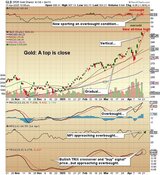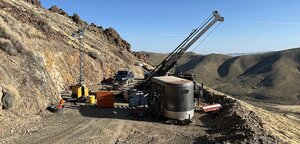The Gold Report: In January, Haywood Securities forecast a copper price above $3.60/pound ($3.60/lb) for the remainder of 2013. Six months later, copper is struggling to remain above $3/lb. What is causing the weakness?
Stefan Ioannou: A lot of it relates to uncertainty regarding the global economic situation. Early in the year, the price hovered around $3.25–3.50/lb and recently nosedived to $3/lb. That happened on the back of Federal Reserve Chairman Ben Bernanke's hints that quantitative easing in the United States may end in mid-2014, raising concerns that U.S. demand for raw goods will decline. Because copper goes into a lot of raw goods, that supposes less demand. In addition, copper inventories are well over 600,000 tons (600 Kt), which is high on a historic basis.
China is the other big concern. Its manufacturing numbers are weakening. People are worried that China, which really drives a lot of the metal stories, is not growing as fast as expected.
TGR: Have you revised your price deck?
SI: In early June we lowered copper's average price for 2013 to $3.35/lb. Year to date, the average copper price is $3.43/lb.
TGR: Is that why the landslide in early April at the Bingham Canyon copper mine in Utah, operated by Rio Tinto Plc (RIO:NYSE; RIO:ASX; RIO:LSE; RTPPF:OTCPK) subsidiary Kennecott Utah Copper Corp., has not had more of an impact on the copper price?
SI: It is probably a combination of two things. One, investors are very focused on the global economic data and general market sentiment. Two, there have been a handful of mine-specific issues, Bingham Canyon being an important one.
Bingham Canyon was about a 165 million ton (165 Mt) failure, which is quite large. It will take a long time to dig out and get the mine back up to steady, safe production. There has not been much disclosure into what the impact will be. I anticipate the Q2/13 results will include commentary, now that the company has had time to assess the damage.
There have been two other mine-specific issues in the copper space. Twenty-eight people were killed at Freeport-McMoRan Copper & Gold Inc.'s (FCX:NYSE) Grasberg mine in Indonesia in mid-May. The mine was shut down for several weeks and is just now ramping back up.
The third mine-specific issue happened in China in early June. One of Jinchuan Group Co. Ltd.'s smelters declared force majeure due to a major equipment failure that prevented it from producing enough refined copper for its end users. Again, there is not a lot of information on that.
But, overall, I think most investors are focused on the global macroeconomic issues, not on specific issues at copper projects.
TGR: Some of the world's biggest miners, like Rio Tinto and BHP Billiton Ltd. (BHP:NYSE; BHPLF:OTCPK), have posted "for sale" signs on noncore assets. Some midtier base metals players have bought what might be considered bargains. Is this an investment thesis worth following?
SI: There is definitely a shift in what the majors are including in their quarterly results, their management discussion and analyses, and the question periods during their conference calls.
They are shifting focus to their existing mines, emphasizing cost-cutting and efficiency measures. There is less talk about pursuing larger, capital-intensive development projects. These are being shelved or put up for sale, creating buying opportunities for midtiers.
A recent example is Capstone Mining Corp.'s (CS:TSX) purchase of the Pinto Valley mine in Arizona from BHP, for about $650 million ($650M). Based on our analysis, Capstone did not overpay, but it definitely was not a bargain.
TGR: Can Pinto Valley be profitable at $3/lb copper?
SI: Yes, I think so. It is a low-grade mine, but with an estimated US$1.80/lb average total copper cash cost over the next five years, it has space.
TGR: What are Capstone's other producing assets?
SI: The company has two mines in production, Minto in the Yukon and Cozamin in Mexico. Both are high-grade projects with modest capital expenses, each producing about 40 million pounds (40 Mlb) of copper per year. Pinto Valley will be an operating mine on Capstone's financial statements by year-end.
The real growth step for Capstone is its Santo Domingo project in Chile. It is a game changer for Capstone—a multibillion-dollar project, low grade, very big tonnage. It also has associated byproduct credits: iron ore (magnetite) concentrate.
Our model shows Capstone's cash cost profile, Minto and Cozamin combined, at $1.90–2/lb for 2013 and 2014. As we add Pinto Valley and Santo Domingo, the company's long-term average cost decreases below $1/lb net of byproduct credits.
TGR: You calculate that Capstone is trading at roughly 0.4 times net asset value (NAV). Is that a typical multiple for midtier companies in this space?
SI: You have to be careful looking at the metrics on a company like Capstone because it has such a significant growth profile. With most established producers, people look at operating cash flow this year and maybe next year, and put a multiple on that.
"Majors are shifting focus to their existing mines, emphasizing cost-cutting and efficiency measures. There is less talk about pursuing larger, capital-intensive development projects."
This year and next, Capstone is producing 80 Mlb copper. Looking out three to five years, it could be producing up to 400 Mlb/year. Near-term cash flow does not represent the company's overall potential. You have to look at NAV, which brings in additional value for something like Santo Domingo. Our target price for Capstone is $3.50/share.
TGR: Have other midtier miners bought assets from a major producer lately?
SI: Not among our direct coverage. Usually, it is the opposite way around—the majors buying assets from juniors once the junior has developed as far as possible before hitting that financing wall.
TGR: Southeastern Europe is emerging as a copper district; some are comparing it to the Democratic Republic of the Congo (DRC). One exploration drill returned 7.2% copper. What is happening there?
SI: That was drilled by Reservoir Minerals Inc. (RMC:TSX.V). It was a spectacular drill hole in the Timok magmatic complex in Serbia. This is a joint venture between Reservoir and Freeport-McMoRan. At the end of the day, Freeport stands to own 75% of the project following the completion of a full feasibility study. Freeport is in the driver's seat, and Reservoir is along for the ride.
This is a historic copper mining district. There are two geologic targets, and each company has an interest that is slanted to one or the other. Reservoir's intersect is in a high-sulphidation zone, which is usually a complex zone above a larger copper porphyry deposit. The geophysics suggest a significantly larger copper porphyry target beneath the high-sulphidation target. Reservoir is interested in the splashy, high-grade drill results from the upper zone and Freeport is looking at the porphyry potential at depth. We will see how it plays out.
You have to drill through the high-sulphidation zone to get into the copper porphyry, which means you get drill results from both zones. We do not know the size of the high-sulphidation zone, but it could, at the least, be interesting to a midtier producer. If the porphyry target at depth pans out, it would likely interest a major.
TGR: It will require more discoveries to qualify this as an area play.
SI: Yes. There are some juniors poking around nearby Reservoir. The jury is still out on the size and grade potential of the porphyry. In the meantime, the high-grade, high-sulphidation at surface has caught the market's attention.
TGR: In your last interview with Streetwise Reports, you said that all-in costs for copper miners averaged $2–2.50/lb. What is the average, all-in cost-per-pound among your top three picks in the copper space?
SI: For Capstone, we are modeling $1.90–2/lb for its two combined mines this year and next year. But, once Santo Domingo is in production, its average corporate copper cash cost will be closer to $1/lb net of byproduct credits, making it a fairly low-cost producer.
Copper Mountain Mining Corp. (CUM:TSX) is just ramping up production, but as it reaches steady-state production, we anticipate costs over the next year on the order of $1.30–1.50/lb.
Nevsun Resources Ltd. (NSU:TSX; NSU:NYSE.MKT) is just finishing up gold production at its Bisha mine in Eritrea. Looking at 2014 to 2016, it becomes a copper-dominant producer at fairly high grades. Because of that, we see its copper costs below $1.25/lb.
It is fair to say most copper companies, even the higher cost ones, are still producing copper at below $2.50/lb.
TGR: Copper Mountain recently made emergency repairs at its mill. Is that taken care of and is it on track to meet its targets?
SI: It has been a slow and tedious ramp-up. Copper Mountain finished building the mine in 2011 and has struggled with throughput issues ever since. The mine is designed to do 35,000 metric tons per day (35 Kmtpd) throughput. The ore is of variable hardness and is generally harder than expected. The company has tried various solutions and optimizations.
Unfortunately in late May, the transformer in its semi-autogenous grinding (SAG) mill, a key piece of milling equipment, failed. Copper Mountain had to take the SAG mill offline. Luckily, it was able to swap transformers from one of its two ball mills. But this temporary swap meant the SAG mill was running at lower-than-designed capacity for a few weeks. A new transformer has been installed and once the company reaches and maintains 35 Ktpd average throughput, the stock should be off to the races.
TGR: Your target price on Copper Mountain is $3/share. It was an investor darling a couple of years ago. Will it reach those levels again?
SI: Copper Mountain is a low-grade mine, which gives it significant leverage to the copper price. It is certainly an interesting play for copper bulls.
Market sentiment is negative on the copper price. You also have this lingering ramp-up fatigue. Once investors get over those two issues, Copper Mountain is due for a significant correction.
TGR: As you said, Nevsun has almost wrapped up mining the oxide—mostly gold—portion and is getting into the supergene ore, which is mostly copper. There can be hiccups going from oxide to supergene operations. Does Nevsun have a good grip on the geology?
SI: The fundamental difference is in the processing techniques. The upfront milling—making the rock smaller—is pretty much the same. The differences are in the back end.
In the case of the supergene, you float a metal concentrate, which you then truck to a port and ship out on a boat. Oxide gold requires a carbon-in-leach circuit to produce gold dore bars, which you then put on an airplane and send to Europe for sale.
"Look for good projects in safe jurisdictions, led by good management teams. All three of these ingredients are essential."
From a geology point of view, in early 2012, the company had a significant reserve reconciliation problem in its oxide zone. A lot of that relates to the fact that oxides are, by their very nature, weathered rock and in some cases are not very competent. When the company drilled the oxide resource and reserve off, it had some core recovery issues in the reserve calculations. Nevsun did not have nearly as much gold as it initially estimated in the mine plan. That had a significant impact on the stock.
When you get into the primary copper and zinc mineralization, that rock is significantly more competent from a geology or a resource/reserve definition point of view. From a statistical point of view, you can deduce a lot more from it without leaving room for a significant error as happened in the oxide.
While there is always some risk in transitioning, it should be significantly less than we saw in the oxide.
TGR: What is your target price on Nevsun?
SI: Nevsun is $4.50/share.
TGR: Zinc is another metal with weak prices, but you believe higher zinc prices are not that far off. Why is that?
SI: Zinc is our choice for a base metal to be bullish on in the medium term. Inventory on the London Metals Exchange has been very high for more than 12 months, topping 1.2 Mt not too long ago. Now, it stands at just over 1 Mt.
The interesting dynamic here is the recent closure of several very large zinc mines. There is nothing fundamentally wrong operationally with these mines; they have simply run their course. In March, Xstrata Plc (XTA:LSE) shut down its Brunswick mine in New Brunswick, which produced almost 2% of the world's zinc.
The last full year of production for the Century mine in Australia, owned by China Minmetals Corp. (CMIN:CH), is likely to be 2015. That mine accounts for almost 4% of world supply.
When you add up all the mines coming off in the next two to three years, it represents more than 10% of global supply.
The zinc market differs from the copper market in that smaller mines predominate. New advanced-stage zinc projects cannot meet that supply loss, let alone additional demand growth. Despite today's high inventories, mines closing in 2014 and 2015 and the lack of new projects will squeeze the supply side and drive the price higher.
You can count the number of good zinc mines on one hand. Anyone who has any reasonable exposure to zinc stands to do well when the zinc price runs.
TGR: What are some of those zinc names?
SI: The go-to name will arguably be Trevali Mining Corp. (TV:TSX; TREVF:OTCQX). The company's Santander mine in Peru is on the verge of commissioning. Its second project, Caribou, is in the Brunswick camp of New Brunswick. It should be in production by early 2014. Trevali will be one of the first junior to midtier zinc-focused companies to hit the ground running as an actual producer. That status alone ensures attention when the zinc price runs.
TMR: Santander is a past-producing mine. It was mothballed for a while due to cost problems. What will make it a profitable operation now?
SI: It is a completely different mine now. Back then it was mining from what it called the Santander pit. Now, it has underground ramp access to operations and a new mill, in which Glencore International Plc (GLEN:LSE; 0805:SEHK) is a significant partner.
This gives it a very different cost structure. The mine should make money at any price north of $0.50/lb.
TGR: Trevali owns 100% of Santander. Is the local community on board?
SI: Trevali has done a good job working with the communities and gaining support for mine redevelopment.
Peru in general is a favorable mining jurisdiction, as is Chile. In Argentina, on the other hand, the government has proposed a significant additional tax and royalty structure that would have a negative impact.
TGR: As you suggested, the Caribou mill and mine are about a year away from production. What is the upside for Trevali?
SI: Looking at Trevali's two mines together, the company will be producing upward of 200 Mlb/year zinc in three or four years. By then, with a significantly higher zinc price, the company stands to generate significant cash flow and to have a significant treasury.
At 200 Mlb/year, Trevali becomes a target. Nyrstar NV (NYR:BR) took out Breakwater Resources Ltd. at roughly a 40% premium to market. It also took out Farallon Mining Ltd. at roughly a 30% premium to market in early 2011. The junior's G9 mine in Mexico was ramping up to about 120 Mlb of zinc production per annum at the time.
In the zinc space, we would not be surprised to see the majors come down the food chain, given there isn't much any bigger than what you see in a company like Trevali.
TGR: What is your price target on Trevali?
SI: My target is $1.35/share.
TGR: What other development-stage targets or companies are you following?
SI: Foran Mining Corp. (FOM:TSX.V) is a copper-zinc or zinc-copper story, depending on how you slice and dice it. Its primary project is McIlvenna Bay, located in Saskatchewan. It shares the geology of the Flin Flon greenstone belt that extends over into Manitoba. That is significant, in that the Flin Flon belt is where HudBay Minerals Inc.'s (HBM:TSX; HBM:NYSE) 777 and Lalor mines are. As a result, the regional infrastructure is outstanding: paved highways, power, etc. HudBay even has a zinc refinery there.
McIlvenna Bay is a very large deposit, a little over 25 Mt in total resources. It is the third largest zinc deposit discovered in this world-class mining camp.
Of the other juniors working in the Flin Flon greenstone belt, no other project is as large, and most are involved in joint ventures with HudBay, which would take the lion's share of those projects for next to nothing. Foran, however, owns 100%.
TGR: A couple of years ago, HudBay Minerals bought the Lalor gold-copper-zinc mine near Snow Lake, Manitoba. That provides ore for HudBay's mill. Is HudBay a realistic suitor in the near term?
SI: In the coming year or so, Lalor is the obvious focus. But HudBay has a huge investment in infrastructure up there. The last thing it wants to do is shut down the Flin Flon camp. The longer HudBay can keep it producing, the better. I view McIlvenna Bay as the next Lalor-type of transaction for HudBay. And HudBay would want to make that move before Lalor actually runs out of reserves because it will have to go through prefeasibility, feasibility study, permitting, design and construction.
Obviously, McIlvenna Bay is years out, but these projects take years to develop.
TGR: How is Foran's development coming along?
SI: Foran's most recent technical milestone is an integrated resource estimate. Previously, there were two resources, one for the zinc-rich, massive sulphide portion of the deposit and another for the footwall stringer zone, which is generally copper rich.
By combining the two and doing some additional drilling, it has a very solid resource model in hand now: more than 25 Mt on a total resource basis.
This summer, it is advancing additional technical and metallurgical work. That will feed into a preliminary feasibility study and set the stage for a full feasibility study.
TGR: What is your price target on Foran?
SI: It is $0.65/share.
TGR: Do you have one more development-stage zinc play?
SI: Donner Metals Ltd. (DON:TSX.V) is already in production, in a joint venture with Xstrata, on a mine called Bracemac-McLeod in a historic mining camp called Matagami in Québec. Donner owns 35% of the mine; Xstrata owns 65% and is the operator. Xstrata has been operating in the region for years and has an established mill. That limits the execution risk.
Donner started producing concentrate from Bracemac-McLeod ore in mid-May. With the way the payment schedules work in the joint venture, Donner will not receive any revenue on the zinc concentrate until 30 days after shipment. For the copper, the revenue will not come in until 90 days after shipment. As a result, even though Donner is generating revenue, it has has monthly cash calls from Xstrata for its share of operating costs and the capital costs of underground development. Donner just announced a deal to raise an additional $4.5M. I think the market in general was under the impression that it was already fully financed. This suggests otherwise. If Donner cannot get this deal done, it may have financial trouble ahead.
To be fair, a lot of that comes on the back of the zinc price. Donner's previous financings were done when zinc was $0.95/lb. Since then, zinc has fallen toward $0.80/lb. That affects Donner's ability to generate near-term cash and meet the payment schedule on Xstrata's cash calls.
TGR: Donner has a royalty deal in place with Sandstorm Metals & Energy Ltd. (SND:TSX.V). Is that not sufficient to cover this shortfall?
SI: The deal with Sandstorm gave Donner $25M up front to pay for its share of capital costs at Bracemac-McLeod. In return, Sandstorm got a metal streaming agreement on Bracemac-McLeod's copper, gold and silver production. As development went on, Sandstorm invested another $10M in exchange for additional streaming.
From Donner's point of view, its key revenue driver now is zinc, because Sandstorm takes a lot of the value that comes out of the copper, gold and silver.
TGR: Finally, let's touch on nickel. Nickel prices peaked near $50,000 per metric ton ($50K/Mt) in 2007 and are hovering at around $14K/Mt today. That is mostly due to nickel pig iron, a crude substitute for refined nickel, made from low-grade nickel laterite ore. Is there any relief in sight for nickel investors?
SI: Obviously, people are focused on the current spot price, which is $6.15/lb and dropping daily.
Pig iron has put a cap on the upside to the nickel price. The high prices in 2007 prompted a flood of nickel pig iron onto the market. At the time, a lot of the laterite ores being mined for pig iron were relatively high grade: 3–4+% nickel. Since then, that ore has been displaced by lower-grade ore: below 2% nickel, even below 1%. That increases the intrinsic cost of producing nickel from that ore.
Producing pig iron from laterite ore is energy intensive. Much of the processing happens in China, where power costs have gone up. When you couple lower-grade input feed with higher energy costs, the result is a higher cost base for pig iron production. Companies—and they are mostly small, mom-and-pop operations—whose start-up and capital costs are sunk, continue to make money at $6–7/lb nickel. But we do not expect to see any significant new nickel pig iron producers come onstream until nickel gets up to $10+/lb.
TGR: Yet, according to the International Nickel Study Group, the surplus of refined nickel at the end of April was close to 33 Kt and it forecasts a 90 Kt surplus this year. Do institutional investors have any appetite to bring more nickel projects into production?
SI: In the near term, there is a lack of interest in the nickel space. It is probably the longest term base metal to get excited about.
The numbers to support nickel on a long-term basis start with China, which continues to build out infrastructure. Historically speaking, the initial infrastructure in emerging economies is built on low-grade iron work. As a country's infrastructure and general wealth increase on a per-capita basis, the amount of high-grade steel consumption increases on a per-capita basis. China is still building out. As it moves into higher standards of living, coupled with the size of the population, you can make a bullish case for significantly higher nickel demand. The same will happen in India a decade or two later.
TGR: Do you follow any nickel stories?
SI: The only name on our coverage list is Royal Nickel Corp. (RNX:TSX), a story that fits that long-term thesis. It is a very large sulphide deposit in Québec's Abitibi greenstone belt, directly adjacent to the key infrastructure. This is the kind of asset that would attract a major player looking to secure a long-term nickel supply spanning multiple commodity price cycles.
There are three basic sources of nickel globally. Sulphide is the most traditional, and is our favorite. A nickel concentrate is made and shipped to a smelter to produce finished nickel. The second is laterite ore. Here, weathered sulphide material is mined, essentially in the form of semi-consolidated dirt. There are a lot of processing challenges, capital costs and risks associated with these projects. Most laterite deposits in the last 20 years have had high capital cost escalations and technical problems. We see these as high risk and generally avoid them. The third one is pig iron, which we already talked about.
TGR: The Chinese are mining nickel in Québec. Are they a potential suitor for Royal Nickel?
SI: Royal Nickel has a memorandum of understanding in place with Tsingshan Holding Group Co. Ltd.
Royal Nickel can produce very high-grade nickel concentrate, on the order of 29%, compared to less than 20% at most other nickel sulphide projects. Technical work shows that you can feed that concentrate directly into the steel mill without a refining process, which has caught the Chinese group's interest.
In addition, Royal Nickel just finished a feasibility study. It will be the foundation for discussing the economics and how to move forward. Management has made clear its interest in selling a 30+% project interest to a strategic partner to help finance the project.
TGR: What is your target on Royal Nickel?
SI: It is $0.75/share.
TGR: Any parting thoughts, Stefan?
SI: We think zinc is a very interesting thesis in the next 12 months.
It is important to do your homework. Look for good projects in safe jurisdictions, led by good management teams. All three of these ingredients are essential, especially given the market's negative sentiment right now. Companies that require near-term financing will be challenged.
TGR: Stefan, we appreciate your insights.
Stefan Ioannou has spent the last seven years as a mining analyst covering mid-cap base metal companies at Haywood Securities. Prior to joining Haywood, he worked with a number of exploration and mining companies, as well as government agencies as a field geologist in Nevada and throughout the Canadian Shield in both the gold and base metal sectors.
Want to read more Gold Report interviews like this? Sign up for our free e-newsletter, and you'll learn when new articles have been published. To see a list of recent interviews with industry analysts and commentators, visit our Streetwise Interviews page.
DISCLOSURE:
1) Brian Sylvester conducted this interview for The Gold Report and provides services to The Gold Report as an independent contractor. He or his family own shares of the following companies mentioned in this interview: None.
2) The following companies mentioned in the interview are sponsors of The Gold Report: Trevali Mining Corp., Foran Mining Corp. and Royal Nickel Corp. Streetwise Reports does not accept stock in exchange for its services or as sponsorship payment.
3) Stefan Ioannou: I or my family own shares of the following companies mentioned in this interview: None. I personally am or my family is paid by the following companies mentioned in this interview: None. My company has a financial relationship with the following companies mentioned in this interview: Donner Metals Ltd. and Trevali Resources Corp. I was not paid by Streetwise Reports for participating in this interview. Comments and opinions expressed are my own comments and opinions. I had the opportunity to review the interview for accuracy as of the date of the interview and am responsible for the content of the interview.
4) As of the end of the month immediately preceding this publication either Haywood Securities, Inc., one of its subsidiaries, its officers or directors beneficially owned 1% or more of Donner Metals Ltd.
5) Interviews are edited for clarity. Streetwise Reports does not make editorial comments or change experts' statements without their consent.
6) The interview does not constitute investment advice. Each reader is encouraged to consult with his or her individual financial professional and any action a reader takes as a result of information presented here is his or her own responsibility. By opening this page, each reader accepts and agrees to Streetwise Reports' terms of use and full legal disclaimer.
7) From time to time, Streetwise Reports LLC and its directors, officers, employees or members of their families, as well as persons interviewed for articles and interviews on the site, may have a long or short position in securities mentioned and may make purchases and/or sales of those securities in the open market or otherwise.








































